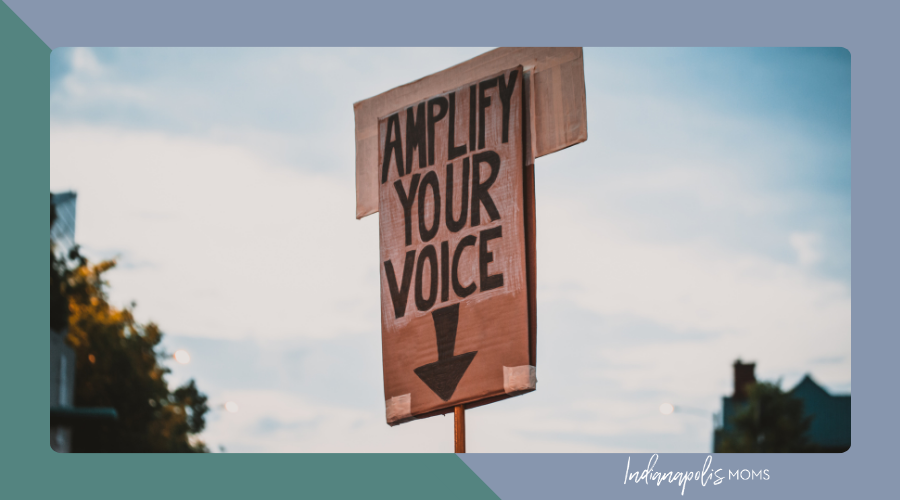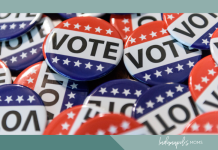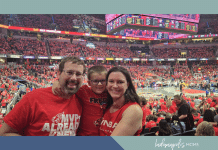 I set markers and poster board down for my then five year old to make her sign. She had been going with me to the voting booth since the womb, so when I shared that there was to be a rally down at the statehouse to gather in support of the rights of women and girls, she wanted to go. Her sign was covered in beautiful and colorful designs. There were lines and circles; we will call it abstract art. In the middle was a picture of a person, carefully drawn in that special kindergarten way. She wrote the word ‘no’ next to it. She then asked me to trace her hand on the board. After tracing both hands, she said she was done.
I set markers and poster board down for my then five year old to make her sign. She had been going with me to the voting booth since the womb, so when I shared that there was to be a rally down at the statehouse to gather in support of the rights of women and girls, she wanted to go. Her sign was covered in beautiful and colorful designs. There were lines and circles; we will call it abstract art. In the middle was a picture of a person, carefully drawn in that special kindergarten way. She wrote the word ‘no’ next to it. She then asked me to trace her hand on the board. After tracing both hands, she said she was done.
“Tell me about what your sign means to you,” I asked her.
She proudly held it up and replied, “It says hands off my body. It’s mine!”
Encouraging your child to create their own protest signs allows them to engage with complex things in a simple and creative way. When children express their thoughts through drawings or messages for a protest, they practice critical thinking: What do I care about? What message do I want to convey? How can I express it clearly and kindly?
I have never met a parent who did not want to raise compassionate and caring children. Our kids listen and understand more than we know, so our job is to start early in finding active ways to nurture their questions, discuss solutions, and help them participate in actions to make something better. We can absolutely include our kids in peaceful protests and discuss topics of justice and democracy in a developmentally appropriate way. We are teaching them to stand up—not just for themselves, but for others.
Can you recall a time in your life when you knew that your voice mattered? It may be a time that you comforted a friend, spoke up for a child being bullied at school, or just advocated for yourself. I never grasped how powerful my words and actions could be until I was in high school. When I became a mom, I knew I wanted that realization to start early for my kids, and so, by normalizing civic engagement, we can teach children that everyone, regardless of age, can and will make a difference.
This process enhances communication skills and builds confidence. Holding up a sign they made—even ones that simply look like scribbles to an outsider- can empower children and help adults understand their perspectives. Children don’t need to grasp every detail of a cause to participate meaningfully; understanding values like fairness, justice, compassion, and responsibility is what truly matters.
Starting conversations about activism will not push them toward a specific political ideology, but it will instill values of empathy and curiosity. It will help children be unafraid to speak up, appreciate the power of working collaboratively, and feel connected to their communities and the world.
Research indicates that young people who experience activism, voting, and community service are more likely to become engaged citizens as adults. Civic engagement cultivates leadership skills, empathy, resilience, and a deeper understanding of one’s role within society. Just as democracy is not simply voting every few years, it requires ongoing involvement. Allowing my kids to see me join in a crowd peacefully gathered in protest is hopefully helping them to think beyond themselves. These shared experiences can spark important conversations, helping families define their values and navigate complex topics together. In a world where social media and busy lives can create distance, these interactions are priceless.
Bringing children to protests requires careful consideration of safety and age appropriateness. Research beforehand, selecting well-organized, peaceful events, and preparing children for what to expect. A few things that you can do before attending a rally is:
- Discussing potential sights and sounds (What will it look like? What will they hear? How many people will be there?)
- Reviewing safety plans and packing essentials (snacks, water, ear protection) is crucial.
- Discussing all the potential feelings of the day, they may feel nervous or overwhelmed, and they can leave if needed. Respecting their boundaries and emotional needs is essential for a positive experience.
While attending a protest recently, my daughter shared with me that she wanted to be a spectator and not a participant. We had driven to the protest, ready to walk with the crowd, but respecting her choice was an important learning moment as well. We drove around the protesters with our windows down. She heard the chants, read the signs, and took in all that was taking place.
Never in my forty-three years on this earth have I been more sure of my responsibilities as a mother when it comes to preparing my children for the future; their future. Whether my daughter is holding up a sign that she created, my son holding a sign from his stroller, or answering difficult questions about the world around us while driving home in my minivan, it is all inviting them to think bigger and better about the choices they will make.
Need more info on just how to teach your kids about this process? Here are some useful resources!
- Teaching Tolerance
Website: Teaching Tolerance
Offers resources for educators and families to discuss social justice and civic engagement. - The National Constitution Center
Website: National Constitution Center
Provides educational materials on the Constitution and civic responsibilities. - Kids Can Make a Difference
Website: Kids Can Make a Difference
Focuses on empowering children to take action on social issues. - DoSomething.org
Website: DoSomething.org
Encourages young people to engage in social change through campaigns and volunteer opportunities. - Civic Responsibility Resources from PBS
Website: PBS LearningMedia
Offers educational videos and resources about civic responsibility and community involvement.








